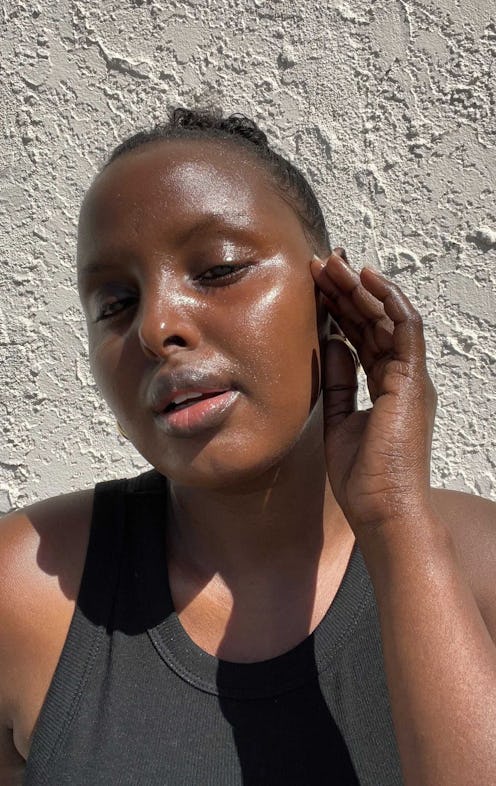Beauty
What To Know About The "Dry Cleansing" Skin Care Hack
Your guide to the face washing practice.
Deciding what type of face wash to use can overwhelm even the savviest beauty aficionados. But, at least you’ve got the cleansing step down, right? Well, if you’re washing your face the most common way (that is, slathering cleanser onto your already damp face), then you might be surprised to learn that there’s another way to slough debris off of your skin. It’s called dry cleansing — or dry washing — and it’s exactly what it sounds like: rubbing cleanser into your dry face with dry hands before you introduce any water.
So, should you be dry cleansing? New Jersey-based esthetician Rosalia Fiske swears by the method. “Dry washing is the best-kept secret in the home skin care universe,” she says. Fiske likens it to spot treating a stain on a blouse in order to get the full concentration of detergent. Still, it’s not quite that straightforward. Miami-based dermatologist Dr. Loretta Ciraldo, M.D., says she’s a big fan of dry cleansing “as long as you’re using the right type of cleanser.” (More on this later.)
Bustle tapped Fiske, Ciraldo, and a couple of other skin care experts for the intel on dry cleansing — keep reading for the full breakdown on the beauty practice.
We may receive a portion of sales if you purchase a product through a link in this article.
Dry Cleansing Benefits
If you’re after a deep cleanse of your skin to do away with oil, dirt, makeup, and unwanted gunk, New York-based dermatologist Dr. Morgan Rabach, M.D. says dry cleansing is probably the best way to accomplish that. As touched on above, that’s because your complexion is getting the full concentration of your face wash when your skin isn’t damp. “Since you’re not diluting the actives with water you can get a more concentrated delivery of beneficial actives for better results from the cleanser,” says Ciraldo.
Risks Of Dry Cleansing
Before you fully adopt a new cleansing habit, keep in mind that dry washing is not foolproof. “Dry cleansing with certain products can be irritating to sensitive skin or those with inflammatory skin conditions,” says Dr. Ryan Turner, M.D., a New York City-based dermatologist. This, Turner says, is because the lack of water can mean increased friction on the skin, and some harsher actives should absolutely be diluted with water. “It is always preferred that people use products as directed on the packaging for the best results,” he notes.
So, which ingredients should give you pause before dry cleansing? Turner says to stay away from alcohol and fragrance, for a couple of examples, as both ingredients can cause irritation. “Some facial soaps that contain acids like salicylic acid and glycolic acid may be too drying or irritating if used without the buffer of water,” adds Rabach. She says to also be wary of acne-fighting washes with benzoyl peroxide, as it can also be rough on the skin. And, in the end, dry cleansing may just not be for you because of that unpleasant soap-without-water stickiness.
How To Dry Cleanse
Rabach stops short of actually recommending dry cleansing. “The most important thing is to wash your face in the morning and night,” making sure all your makeup is removed. But if you’re feeling like giving dry washing a go, here’s how to do it.
1. Choose The Right Cleanser
“The ideal cleanser is one with nourishing actives,” says Ciraldo. Think hyaluronic acid, aloe vera, ceramides, and plant-based oils. Fiske suggests staying away from foaming cleansers as they tend to contain surfactants (compounds that reduce the surface tension between two liquids) which can be harsh on complexions. Instead, she recommends oil-based and creamy cleansers.
2. Massage Into Skin
With dry hands, work the cleanser into your dry face using upward strokes. “The cleanser is getting into those pores and loosening anything that’s not supposed to be there, like debris, dirt, oil, and bacteria,” says Fiske. Let the product sit on your skin for a minute or two.
3. Massage Again With Wet Hands
Then, wet your hands with lukewarm water. “Hot water can be too dehydrating,” Fiske notes. “Repeat the same movement and literally wash away what the cleanser broke up.”
4. Rinse Thoroughly
Splash your face with tepid water until the cleanser is thoroughly rinsed away, Ciraldo says. Pat dry with a clean towel, and you’re ready for the rest of your routine.
Experts:
Rosalia Fiske, licensed New Jersey-based esthetician
Dr. Ryan Turner, M.D., board-certified New York City-based dermatologist
Dr. Loretta Ciraldo, M.D. board-certified Miami-based dermatologist and founder of Dr. Loretta Skincare
Dr. Morgan Rabach, M.D., board-certified New York City-based dermatologist
This article was originally published on
